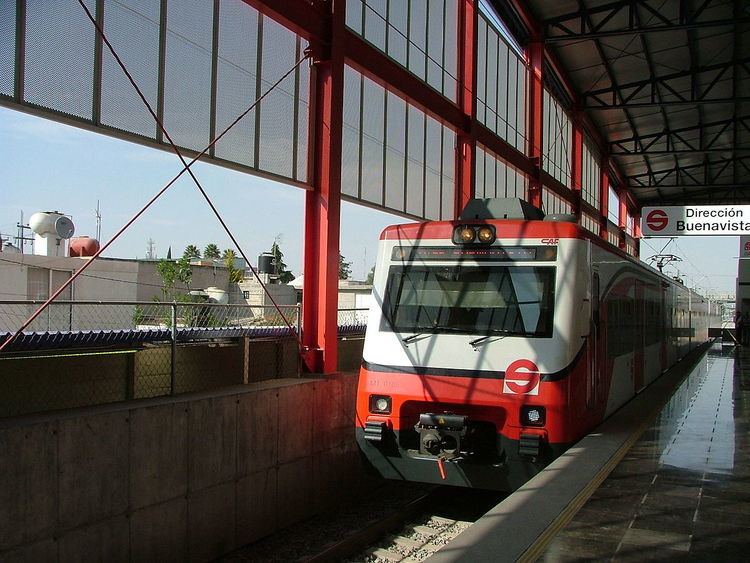Transit type Suburban rail Daily ridership 88,000 | Number of stations 7 Headquarters Mexico City | |
 | ||
Locale Distrito Federal, Mexico Number of lines 1 (with 2 more additional lines under construction) | ||
The Ferrocarril Suburbano de la Zona Metropolitana del Valle de México (Suburban Railway of the Valley of Mexico Metropolitan Area) is an electric suburban rail system in Mexico City. It is also known as Valley of Mexico Suburban Rail System and colloquially referred to as El Tren Suburbano. It is designed to complement the extensive Mexico City metro system, Latin America's largest and busiest urban rail network.
Contents
There are projects to expand in progress and new proposals to expand the total length of the rail system to 242 kilometres (150 mi). The new projects to expand the network will include expansion into the adjacent state of Mexico.
Description
The initial line covers a route measuring 27 kilometres (17 mi) from Mexico City's Buenavista Station north to Cuautitlán, in the State of Mexico. This initial section, which began commercial service on June 2, 2008 (after three weeks of fare-free trial operation), cost US$706 million to build, with the Mexican Federal Government contributing 55% of this investment.
The inaugural demonstration trip of the service from Buenavista to Lechería station and back again was made by the President of Mexico, Felipe Calderon Hinojosa, and the Governor of the State of Mexico Enrique Peña Nieto with President Calderon acting as the train's engineer.
The line was built on an existing railroad right of way. However, inside Mexico City itself on the approach to Buenavista Station, a considerable amount of grade separation, including below-grade excavation and new bridges was necessary due to high density and traffic congestion. The construction elicited complaints by some Mexico City residents who objected to having their neighborhoods split by the rail line, but overall the public has supported the project.
In addition to the track, the construction of Tren Suburbano also benefited from like-new electrification infrastructure already in place along most of the route, part of National Railways of Mexico (NdeM)'s Mexico City-Querétaro 25 kV 60 Hz mainline electrification completed in the 1990s but de-energized a few years later after NdeM was privatized.
On August 24, 2005, CAF (Construcciones y Auxiliar de Ferrocarriles, S.A.) obtained a 30-year concession to supply rolling stock, build and operate the Tren Suburbano. The trains used on this service are electric trains built by CAF and are similar to the series 2000 trains of the Companhia Paulista de Trens Metropolitanos of São Paulo, Brazil.
Ridership
The line is projected to carry 100 million passengers annually. From the period of June 1, 2008 through July 7, 2008, the service carried one million passengers, or an average of approximately 30,000 passengers per day, which is a rate far below the annual projections. As of January 31, 2010 according to the head of Comercialización y Administración de Riesgos del Ferrocarril Suburbano stated that Line 1 of the Suburban Railway of the Mexico City Metropolitan Area serviced an average of 88,000 passengers per day. As of the end of 2012, ridership has reached 132,000 per day, however still falls short of the 192,000 per day the private operator needs in order to stay solvent due to high initial upfront cost and debt schedule, nevertheless this levels the system runs an operational profit, it just isn't high enough to cover accumulated debt repayment yet. Ridership has increased to 184,000 per day as of 2015, thus the system has proven its viability and being expanded. Trains are scheduled every 6 minutes during peak hours.
Fare structure
The fares on this service are 6.50 pesos (approximately US$0.55) for a trip of three or fewer stations and 15.00 pesos (approximately US$1.25) for longer trips of four or more stations. Fares are paid using a rechargeable card that costs 13.00 pesos.
Future expansion
Authorities hope to extend the system as far as it is practical to do so (the current long range plan is for 242 kilometers of lines), in order to reduce Mexico City's heavy road traffic congestion and air pollution. In most cases the system will follow existing rail lines, however grade separations similar to the ones done on the initial segment may be necessary.
In December 2006, SCT announced that approval has been given for the 19.3 kilometres (12.0 mi) System 2, extending to Jardines de Morelos and Martín Carrera, and System 3 of an additional 12.8 km to Chalco and La Paz.
